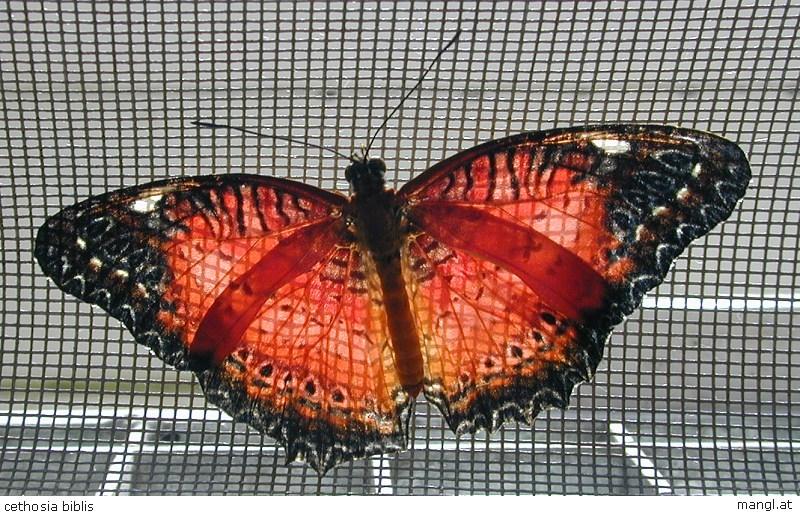Cethosia biblis - Red Lacewing
紅鋸???蝶
Superfamily: PAPILIONOIDEA Family: Nymphalidae Subfamily: Heliconiinae
Tribe: Cethosini Genus: Cethosia Fabricius, 1806 species: biblis (Drury, 1773)
Distribution
Nepal, north-east India, Burma, Indochina, China (Sichuan, Yunnan, Hainan, Guangxi, Guangdong & Hong Kong), Andaman Islands, Thailand. (Bascombe, 1995)
The Butterfly
Cethosia biblis is medium in size and is bright orange red with black margins in colour. The sexes are dimorphic. The female instead of bright orange-red colour is suffused with strong black greyish markings. The butterflies tend to fly low and around their foodplant. The male in particular tends to fly and settles near its foodplant awaiting for the emerging female for mating. Occasionally, single males are found to wander off their breeding sites. This usually happens in the autumn season corresponding to the higher density of the adult butterflies. The female seems to be rarer of the two sexes. They both feed freely on flowers especially Lantana camara. They can be found in large numbers in autumn months.
Voltinism
The adults are generally on the wing from March to December. The butterfly is multivoltine and there are at least 4 or 5 generations in a year. They tend to overwinter as adults or in their pupal stage as Hong Kong has a mild winter. Sometimes the butterfly is found to be very tattered in the winter and spring months. It is though that the butterfly can live for a long period of time before they die by natural courses.
Host plant
The only recorded foodplant in Hong Kong is Passiflora cochinchinensis Spreng of the Passifloraceae family. It is a poisonous climbing plant. Other Passiflora plants of the same family may be found next to the hostplant in the wild but they do not attract the female butterfly at all.
Conservation
In recent years, both the foodplants and butterflies seem to have declined drastically, in particular at Lung Kwu Tan where most of the foodplants were cut during a clean up of the village's cemetery. Paul Lau had dedicated his effort of transplanting some of the foodplants and stock of butterflies to Kadoorie Farm and Lamma Island from Lung Kwu Tan. It is hoped that the butterflies can be conserved and flourished in the years to come. |
